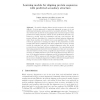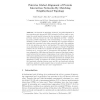2666 search results - page 159 / 534 » Computing with Evolving Proteins |
109
click to vote
RECOMB
2009
Springer
15 years 10 months ago
2009
Springer
Accurately aligning distant protein sequences is notoriously difficult. A recent approach to improving alignment accuracy is to use additional information such as predicted seconda...
102
click to vote
RECOMB
2007
Springer
15 years 10 months ago
2007
Springer
We describe an algorithm, IsoRank, for global alignment of two protein-protein interaction (PPI) networks. IsoRank aims to maximize the overall match between the two networks; in c...
ISMB
1998
14 years 11 months ago
1998
A novel method to model and predict the location and orientation of alpha helices in membrane- spanning proteins is presented. It is based on a hidden Markov model (HMM) with an a...
BMCBI
2004
14 years 10 months ago
2004
Background: Hidden Markov Models (HMMs) have proven very useful in computational biology for such applications as sequence pattern matching, gene-finding, and structure prediction...
RECOMB
2007
Springer
15 years 10 months ago
2007
Springer
Abstract. Sequence to structure alignment is an important step in homology modeling of protein structures. Incorporation of features like secondary structure, solvent accessibility...



